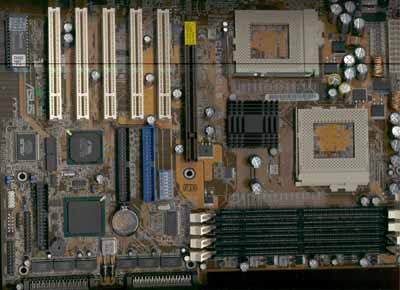Value Dual Socket-370 Motherboard Roundup - August 2001
by Mike Andrawes on August 24, 2001 12:00 PM EST- Posted in
- Motherboards
ASUS CUV4X-DLS
|
ASUS CUV4X-DLS |
|
|
CPU
Interface
|
Socket-370
|
|
Chipset
|
VIA
Apollo Pro133A
VT 694X North Bridge VT 686B South Bridge |
|
Form
Factor
|
ATX
|
|
Bus
Speeds
|
66 / 68 / 75 / 80 / 83 / 85 / 90 / 95 / 100 / 102 / 105 / 110 / 112 / 115 / 116 / 118 / 120 / 124 / 126 / 130 / 133 / 135 / 138 / 140 / 142 / 144 / 146 / 148 / 150 / 155 / 160 / 166 MHz |
|
Voltages
Supported
|
Auto Detect |
|
Memory
Slots
|
4
168-pin DIMM Slots
|
|
Expansion
Slots
|
1
AGP Pro Slot |
|
On-board
Audio
|
N/A
|
|
BIOS
|
Award Medallion BIOS 6.00 |
In early 2001, ASUS also saw the potential of the Apollo Pro133A chipset and
decided to release their own SMP board using the chipset. The result is the
CUV4X-DLS, a quality motherboard that is prepared for high-end server applications.
The most noticeable feature of the board is the SCSI controller instead of the
IDE RAID setup we usually see in this market segment. ASUS has chosen the LSI
LSA0610 32bit Ultra 160 SCSI controller for the CUV4X-DLS, providing two 68-pin
Ultra 160 / Ultra-Wide SCSI connectors on the front edge of the board. With
each channel supporting up to 16 devices, you can connect a total of 32 devices
to the board.


The LSI SCSI controller and the two SCSI connectors.
To further position the CUV4X-DLS in the server market, ASUS has also integrated an Ethernet controller, which comes in quite handy when designing a 1U or 2U server. The controller used on the CUV4X-DLS is the Intel 82559 controller with the Ethernet jack located within the ATX I/O panel, right above the USB ports.


The Intel on-board Ethernet controller and connector
Like other ASUS boards, the CUV4X-DLS uses ASUS's own ASIC for hardware monitoring instead of that included in the 686B South Bridge. We're still not sure why ASUS goes through the extra trouble of this hardware monitoring setup however. The board is also outfitted with four DIMM slots so you have more flexibility in your memory configuration. An AGP Pro slot is also included, so you can use some of the high-end video cards that happen to require such a connector for added power. Of course, regular AGP 4X cards will work just fine as well.

The ASUS ASIC for I/O control.

The AGP Pro slot.

Dipswitches are still available on the board for overclocking.
The board is set by default to operate in jumperless mode, which it does just
fine, but dipswitches are also included, mainly for use by OEM's. Performance
of the board is quite good as well, as was overclocking. Even though the board
does not feature any I/O or CPU core voltage tweaking, we were able to run the
system at 148MHz FSB without giving up any stability.
Most SMP Apollo Pro133A boards do not require a terminator in the second CPU
socket if you are running only one CPU, possibly due to cost cutting measures
since the boards are already so cheap. The CUV4X-DLS is unique in this respect
because ASUS has included such a terminator, possibly to increase stability.











2 Comments
View All Comments
yelo333 - Thursday, May 12, 2005 - link
On the Acorp 6A815EPD page, there is a misspelling:largeer
Just search for it ;)
Oh, and don't ask me why I'm actually reading such an old article :P
29a - Friday, May 8, 2020 - link
I had one of these and a cool thing about it was that the CPUs didn't have to be the same speed.